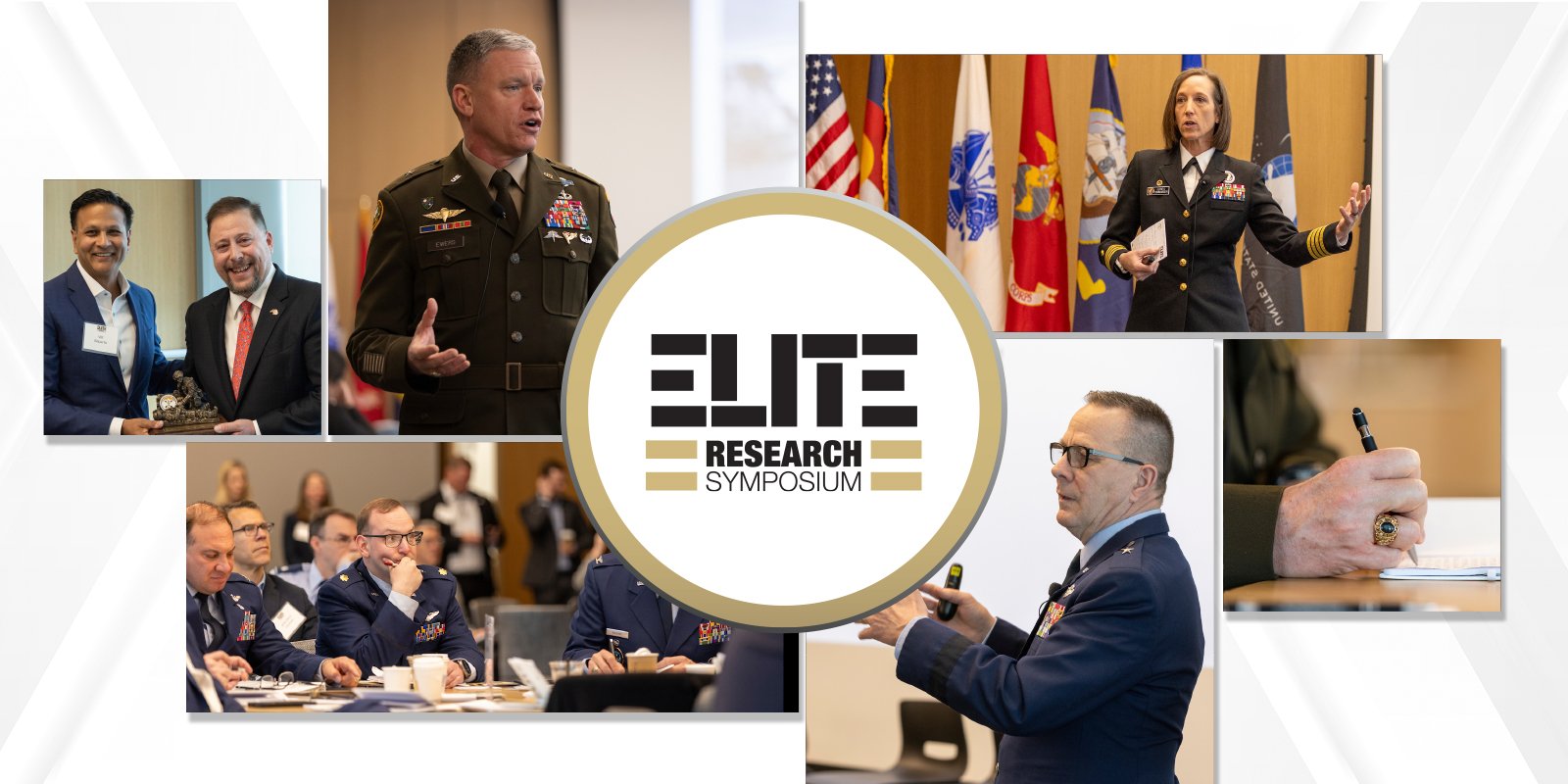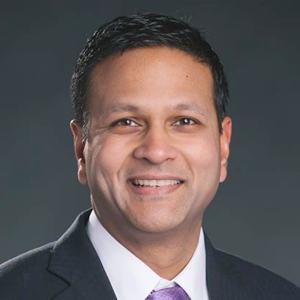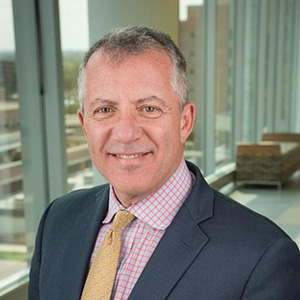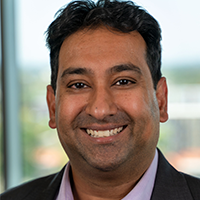The Center for Combat Medicine and Battlefield (COMBAT) Research at the University of Colorado School of Medicine welcomed more than 100 leaders from academia, government, and industry to the CU Anschutz Medical Campus on April 3-4 for its inaugural ELITE Research Symposium. The attendees came together to identify and solve the U.S. military’s toughest medical challenges.
“Some of the folks here have gone to war, some have started companies, some have published in big scientific journals, and that’s exactly why you’re all here,” Vik Bebarta, MD, interim chair of emergency medicine and founder and director of the CU Center for COMBAT Research, told attendees. “These varying experiences add value to our mission. Each of you is your own force multiplier, and together, I think we’re going to solve the challenges that face combat casualty care.”
Each attendee was hand-picked by the center to bring their own specialty and expertise to the symposium, which featured several sessions focused on identifying gaps in military health, collaborative strategies, and the future of innovation.
Setting the stage
The symposium opened with a trio of presentations that framed the challenges ahead of the military and the responsibility to meet them. Speakers brought decades of experience in battlefield medicine, operational leadership, and research innovation to highlight what needs to be done and how the Department of Defense (DoD) and its partners can rise to the occasion.
Brig. Gen. Joseph Ewers, deputy commander of the 7th Infantry Division, urged attendees to rethink battlefield medicine in the context of high-intensity conflict. With future wars likely to involve contested logistics, prolonged field care, and limited connectivity, he stressed the need for adaptable, resilient systems.
“The golden hour is like the dodo bird. It’s gone,” he said, referencing the increased time it may take to evacuate casualties in future theaters. “If your system requires endless power and persistent connectivity, it’s not a good system for the future battlefield.”
Brig. Gen. John Andrus, MD, joint staff surgeon, focused on leadership culture as a foundation for innovation. He encouraged humility, curiosity, and team empowerment.
“Leaders are most effective when they’re humble, when they ask good questions, and when they create space for their teams to set goals and solve problems,” he said, calling for stronger integration of medical efforts into broader defense strategy and emphasizing collaboration across sectors to accelerate life-saving solutions.
Capt. Franca Jones, PhD, commander of the Naval Medical Research Command, offered a personal perspective, sharing how the events of 9/11 inspired her to serve.
“Every day, whether you’re in the military, academia, or industry, you have to wake up and remember your why,” she said. Jones urged attendees to consider not just innovation but the process barriers that prevent it from reaching the field.
“We do a lot of great research. We don’t do enough development,” she said. Jones cited examples like antimicrobial resistance and wearable fatigue tech as areas where promising tools must be moved more effectively from lab to deployment. “We’ve got a lot of work to do to get things out of the freezer and into the fight.”
The speakers pushed attendees to challenge assumptions, close the gaps, and move fast. Whether it’s designing for disconnected battlefields, fostering a culture of innovation, or ensuring that promising technologies reach the warfighter, the future of military medicine depends on bold leadership and relentless follow-through.
 Brig. Gen. Joseph Ewers, Brig. Gen. John Andrus, MD, and Capt. Franca Jones, PhD speak during the opening session of the ELITE Symposium at CU Anschutz
Brig. Gen. Joseph Ewers, Brig. Gen. John Andrus, MD, and Capt. Franca Jones, PhD speak during the opening session of the ELITE Symposium at CU Anschutz
Leading through learning
Building on the themes introduced during the symposium’s opening session, discussions explored some of the most pressing challenges in military medicine, from injury and illness to psychological health, prolonged care, and operations in resource-limited environments.
“I want you to talk, deliberate, debate, get after those tough challenges, and co-design solutions,” Bebarta told attendees.
Col. Jennifer Gurney, head of the Joint Trauma System, led a session on critical gaps in prehospital, prolonged, and en-route care, particularly in future conflicts where evacuation and connectivity may be limited. Adit Ginde, MD, MPH, vice chair of research for emergency medicine, addressed the “17-year odyssey” of translating research into practice and shared strategies to accelerate the delivery of medical innovations to the field. Ellen Embrey, board chair for the Medical Technology Enterprise Consortium and former acting assistant secretary of defense for health affairs, emphasized that closing care gaps will require stronger alignment between private-sector innovation and public-sector investment.
These conversations were grounded in real-world experience and informed by recently deployed participants who underscored the need to better integrate research, operations, and frontline care.
Other sessions focused on data-driven solutions, including using biomedical informatics to manage complexity, digital tools to expand access to psychological care, and strategies to deliver care in austere environments. These areas of research remain central to the mission of the CU Center for COMBAT Research and are helping evolve standards of care in both military and civilian settings.
Enabling innovation
Innovation was discussed not just as technological advancements but as a mindset and methodology for solving complex problems.
Richard Zane, MD, chief innovation officer at UCHealth, and Kimberly Muller, vice chancellor for innovation and biotechnology and executive director of CU Innovations, challenged attendees to consider what new technologies might be needed for combat casualty care and also how to build systems that can be rapidly adopted, scaled, and sustained.
“Innovation isn’t just about shiny new tech,” Zane said during the symposium. “It’s about solving real problems in different, faster ways that make the lives of providers easier and the lives of their patients better.”
Zane and Muller outlined their approach to building an innovation ecosystem across the CU Anschutz campus—one designed to break down silos, embrace calculated risk, and prioritize usability.
True innovation, they emphasized, only succeeds when adopted. However, adoption in healthcare, whether military or civilian, often lags due to cultural resistance and operational friction. Their model flips the traditional venture capital approach. Instead of investing in ideas and hoping for adoption, they identify proven solutions within their health system and then scale them nationally. To increase the likelihood of adoption and sustainability, they reduce the burden on clinicians by removing existing tasks for every new one introduced.
“Innovation has to be scalable,” Zane added. “If it only works at a single academic medical center, it won’t work in a field hospital, a rural clinic, or on the battlefield.”
They encouraged attendees to think systemically and consider how innovation can flow between civilian healthcare and the military. Technologies that support civilian care, such as AI-assisted decision-making, centralized virtual care, and predictive monitoring, could be adapted for combat settings. Likewise, military innovations could strengthen civilian systems back home.
Muller encouraged attendees to reflect on the gaps in deployed care. “Our challenge to you is when you think about the warfighter, you think about the military, or you think about war deployments, what do you wish you had that civilian care has all the time?”
Their message to attendees was to start with culture, move quickly, and elevate early adopters as examples of success. “Start small, go fast, and don’t be afraid to fail—and when you do fail, figure out why and do it better the next time,” Zane said.
 Scenes from the ELITE Symposium, including keynote speakers, engaged attendees, and the opening color guard ceremony.
Scenes from the ELITE Symposium, including keynote speakers, engaged attendees, and the opening color guard ceremony.
Recognizing collaboration
While the symposium focused on identifying challenges and advancing solutions, the CU Center for COMBAT Research also paused to honor individuals driving that progress forward.
Colorado philanthropist Christian Anschutz received the inaugural Inspire Award for his longstanding support of military medicine and the university. Col. (retired) Laura Brosch, PhD, RN, interim vice president for research at the Uniformed Services University, was honored with the Impact Award for her decades of work enabling critical research in combat zones. Her efforts have helped transform trauma care worldwide.
A major theme stood out as the symposium concluded: The future of military medicine will depend not only on breakthrough ideas but on the partnerships, leadership, and urgency required to put those ideas into practice. The ELITE Symposium served as both a catalyst and a call to action, uniting experts around a shared mission to save lives on the battlefield and beyond.





